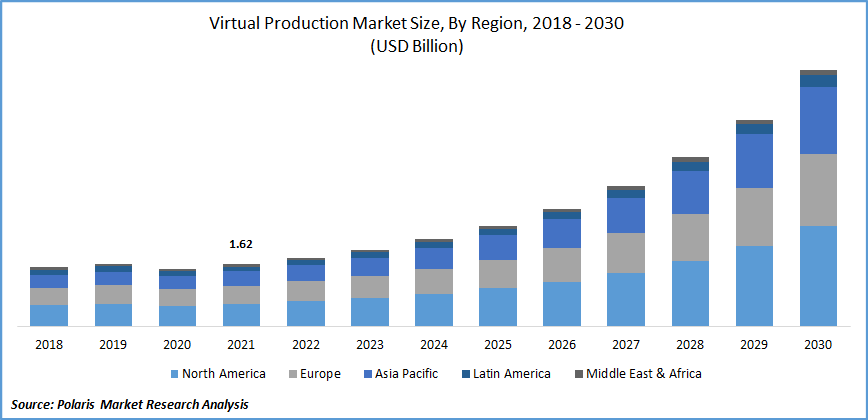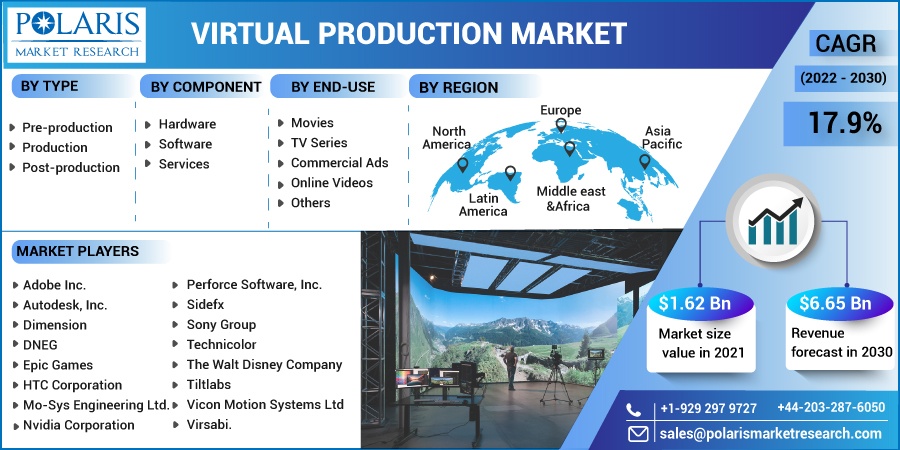
Virtual Production Market Size, Share & Trends Analysis Report
By Type (Pre-production, Production, Post-production); By Component (Hardware, Software, Services); By End-Use; By Region, And Segment Forecasts, 2022 - 2030
- Published Date:Jul-2022
- Pages: 115
- Format: PDF
- Report ID: PM2522
- Base Year: 2021
- Historical Data: 2018-2020
Report Outlook
The global virtual production market was valued at USD 1.62 billion in 2021 and is expected to grow at a CAGR of 17.9% during the forecast period. The increased adoption of virtual content creation methods over traditional content creation techniques is anticipated to accelerate the growth of the industry as it promotes iterative, nonlinear, and collaborative processes.

Know more about this report: Request for sample pages
Over the years, revolutionary technological developments have changed and broadened the course of filmmaking. These innovations consist of computer-generated images, color negative material, simulated reality, optical compositing, motion control, and sound for film. These factors are contributing to augmenting the growth of the industry.
The outbreak of COVIID-19 has impacted every sector of the global economy, including the virtual production market. The entertainment sector has been significantly affected by the global spread of the COVID-19 pandemic, which has interrupted film and television creation and resulted in the closure of cinemas.
However, it has also accelerated the technology-led transition towards virtual creation in film and television. The demand for online content increased as people were stuck inside, and the industry had to innovate in order to meet the demand and the expectations of the masses. Therefore, the integration of advanced technology in the creation method helped producers create content amid the pandemic.
 Know more about this report: Request for sample pages
Know more about this report: Request for sample pages
Industry Dynamics
Growth Drivers
Producers are increasingly using such advanced content creation technologies in their work owing to the success of web programs with visual effects and three-dimensional graphics. Several popular internet and television shows make considerable use of visual graphics to depict epic and historical situations. In order to improve the watching experience, VFX helps create high-quality video material with realistic visual characters and manufactured scenery, which in turn, leads to the demand for the industry.
The growth of the industry is also attributed to the cost-effectiveness associated with the use of virtual creation methods in content creation. By eliminating the need for costly locations and bringing pre-visualization to the set, virtual creation technology also helps to lower video creation costs. In order to help the filmmaker arrange camera placement and other creative/technical requirements, pre-visualization is the process of building a preliminary three-dimensional model of the final visual effects action sequence.
Furthermore, technological advancements in virtual creation technology are projected to accelerate the growth of the industry. It is also anticipated that the use of machine learning and artificial intelligence would enhance the quality of visual effects and streamline the creation of three-dimensional models.
Advanced visual effect software capabilities are predicted to emerge in the near future as a result of the growing usage of artificial intelligence in content creation for action simulation, three-dimensional texturing, and post-process motion-capturing data.
Report Segmentation
The market is primarily segmented on the basis of type, component, end-use, and region.
|
By Type |
By Component |
By End-Use |
By Region |
|
|
|
|
Know more about this report: Request for sample pages
Post-production segment dominated the market in 2021
Based on type, the post-production segment dominated the market in 2021. The overall production's post-production costs are decreased by the use of virtual creation technology. With virtual creation, the ambient LED screen light means the correct light is automatically created, giving the scenario a genuine feel and eliminating additional labor costs in post-production.
In addition, there is no need to sacrifice design when using virtual creation within an LED volume for things like haircuts, costumes, or props. This gives film producers and their team complete freedom over how things look in the film, with no necessity to budget for post-production adjustments because of color, loose hair, pattern, or green spill.
The production segment is expected to account for a significant share over the forecast period. By reproducing a real actor's actions with a virtual camera, performance capture enables video creators to portray an imagined character in action. A live LED wall in the background or a realistic graphics environment generated by a computer can simultaneously display the scenario.
Movies segment accounted for the largest revenue share in the global market in 2021
Based on end-use, the movies segment accounted for the largest revenue share in the global virtual production market in 2021. A significant rise in movie creation costs and a growing dependence on visual effects by Hollywood and other regional studios are driving the growth of the movie industry.
Additionally, film producers now have access to a larger audience owing to the growing trend of shifting movies from theatres and multiplexes to over-the-top (OTT) platforms, which is expected to drive the segment's growth during the forecast period.
North America dominated the market in 2021
North America dominated the market in 2021 in the global market. Massive investments in R&D activities to processing techniques and virtual production market software solutions aid in the expansion of the regional market. Additionally, the growing usage of visual effects in advertisements and sporting events is propelling the regional market.
Asia Pacific is expected to account for a significant share over the forecast period. The demand for the market is expected to be driven by the rising adoption of advanced content creation technology in emerging economies such as China, India, and Japan. With the introduction of artificial intelligence and machine learning technology, the demand for VFX has risen over the years in the region.
For instance, in 2021, Hibino partners with ROE Visual for a virtual production studio in Japan. The Hibino Group, one of Japan's largest AV providers, offers various products and services. Leader in live music and events, Hibino now extends its services by adding the new VFX studio.
Competitive Insight
Some of the major players operating in the global market include Adobe Inc., Autodesk, Inc., Dimension, DNEG, Epic Games, HTC Corporation, Mo-Sys Engineering Ltd., Nvidia Corporation, Perforce Software, Inc., Sidefx, Sony Group, Technicolor, The Walt Disney Company, Tiltlabs, Vicon Motion Systems Ltd, and Virsabi.
Recent Developments
In January 2022, Sony expanded its video creation to another level with crystal LED. Sony Innovation Studios reinvented locations and sets for film and TV productions with its latest technology that captures 3D volumetric point cloud data in Japan.
In 2021, NEP Group announced the launch of a new virtual production business segment namely NEP Virtual Studios in order to bring on board industry leaders in real-time creation with the acquisition of Lux Machina, Prysm Collective, and Halon Entertainment.
Virtual Production Market Report Scope
|
Report Attributes |
Details |
|
Market size value in 2021 |
USD 1.62 billion |
|
Revenue forecast in 2030 |
USD 6.65 billion |
|
CAGR |
17.9% from 2022 - 2030 |
|
Base year |
2021 |
|
Historical data |
2018 - 2020 |
|
Forecast period |
2022 - 2030 |
|
Quantitative units |
Revenue in USD million/billion and CAGR from 2022 to 2030 |
|
Segments covered |
By Type, By Component, By End-Use, By Region |
|
Regional scope |
North America, Europe, Asia Pacific, Latin America, Middle East & Africa |
|
Key companies |
Adobe Inc., Autodesk, Inc., Dimension, DNEG, Epic Games, HTC Corporation, Mo-Sys Engineering Ltd., Nvidia Corporation, Perforce Software, Inc., Sidefx, Sony Group, Technicolor, The Walt Disney Company, Tiltlabs, Vicon Motion Systems Ltd, and Virsabi. |
